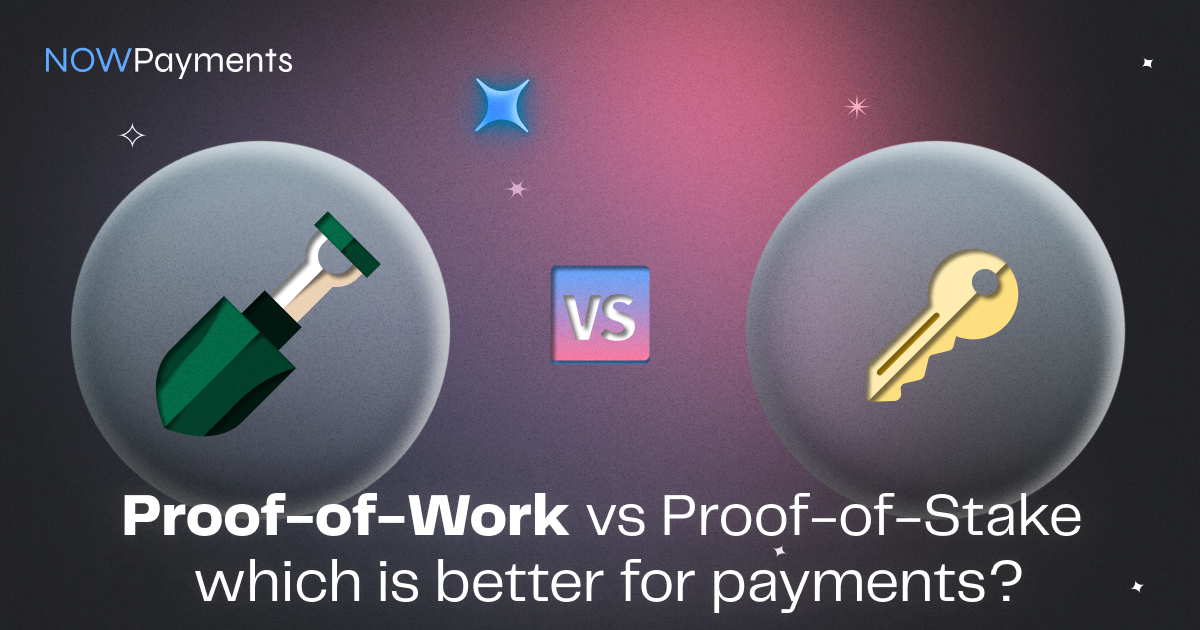A consensus mechanism must be used across all nodes that evaluate the transactions for a blockchain to function. They are used to validate new transactions, include them in the blockchain, and produce new tokens. The two most popular mechanisms used in the largest blockchains are Proof-of-Work (PoW) and Proof-of-Stake (PoS). Let’s discuss how these algorithms work, how they affect crypto payments, and which one has better properties to be used for payments.
Key points:
- The consensus mechanism is an algorithm that dictates how blockchain nodes validate transactions.
- The Proof-of-Work mechanism relies on mining while Proof-of-Stake uses staking to maintain the blockchain.
- PoS is more energy-efficient while PoW is the more reliable of the two.
What is Proof-of-Work?
Proof-of-Work is the original consensus mechanism that was first used by Bitcoin. In order to prove their work, miners must gather online cryptocurrency transaction data and add it to historical records of ownership. However, they must first perform a series of difficult cryptographic operations intended to make any attempted fraud more expensive and, therefore, less likely. To put it simply, they must provide evidence of their work before recommending a new block of transactions.
As a cryptocurrency’s value rises, more miners are encouraged to join, increasing the network’s strength and security. Litecoin, Dogecoin, Zcash, and Dash are just a few of the well-known cryptocurrencies that currently use PoW mechanisms.
What is Proof-of-Stake?
Proof-of-Stake is one of the most popular alternatives to Proof-of-Work. The biggest difference between the two is that the PoS mechanism relies on staking instead of mining. Staking is a method of earning passive income for users that involves locking up their cryptocurrency assets for a predetermined period of time and contributing to the maintenance of a blockchain. As a result, PoS protocols choose validators in accordance with the value of the assets they hold.
This method’s ability to eliminate the computational expense of PoW is one of its biggest benefits. Currently, the PoS mechanism is used by popular crypto coins, including Ethereum, BNB, Cardano, Polkadot, and Avalanche.
How does Proof-of-Work or Proof-of-Stake consensus affect crypto payments?
When comparing the two consensus mechanisms, the key difference is energy consumption. Because validators only lock up predetermined amounts of cryptocurrency instead of solving math problems, PoS blockchains allow networks to operate with significantly lower resource consumption. It also has a lower barrier to entry because becoming a validator doesn’t require expensive equipment.
These differences also have an effect on cryptocurrency payments, as can be seen in the table below.
| Proof-of-Work | Proof-of-Stake | |
| Centralization | Centralized in nature | The winner is determined according to the size of the stake |
| Efficiency | Reliable but more expensive and less energy-efficient | Less reliable but more energy and cost-efficient |
| Speed | Ethereum only processes 30 transactions per second as a proof-of-work blockchain | Through Proof-of-Stake, Ethereum will be able to process anywhere from 20,000 to 100,000 transactions per second |
| Risk of attack | A malicious block can be introduced with 51% of computing power, which is improbable but not impossible | A malicious block can be introduced with 51% of all cryptocurrency on the network, which is virtually impossible |
Which consensus mechanism is better for payments?
While Proof-of-Work has the advantage of robust infrastructure, it comes at a growing environmental cost. As more people become concerned about the energy consumption levels of PoW networks like Bitcoin, the POS mechanism avoids that massive energy consumption. While it hasn’t yet been proven to be as secure and stable as PoW at scale, it’s definitely a better option for environmentally conscious users. PoS networks also come with the advantages of higher decentralization and faster speed.
How to accept crypto payments?
No matter which consensus mechanism you choose for your cryptocurrency payments, it’s important to use a trustworthy and reputable payment service. A non-custodial cryptocurrency payment gateway, NOWPayments, offers instant crypto transactions, fair trading rates and fees, and fiat withdrawals. It allows users to choose from over 50 crypto coins with automatic currency conversions.
To start accepting crypto payments, follow these simple steps:
- Create an account with NOWPayments with your email address and a crypto wallet where your payments will be sent.
- Open your dashboard. Here you will be able to see all the payment tools as well your transaction history.
- To receive payment via a link, go to your account dashboard, click “Payment Tools”, and open the “Payment Link” tab. Select the “Create payment” link, then choose the currency and amount in the pop-up window.
- You can also create donation links and widgets, enable subscriptions, and create your own Point-of-Sale terminal. If you would like to enable mass payments, follow these instructions.
Conclusion
When deciding which particular cryptocurrency to use for payments, comparing the two most common consensus mechanisms—Proof-of-Work and Proof-of-Stake—is crucial. Every system has its advantages and disadvantages, its pros and cons. PoW has a longer track record, and significant infrastructure is built around them. Meanwhile, PoS is superior in efficiency and speed of transactions.
It’s also important to remember that not all blockchains that use the same consensus algorithms are equal. There are also unique properties for each cryptocurrency that should be considered.

